In this article, we aim to look at the properties of hyperbolas and identity equations that describe such conic sections. By familiarizing ourselves with these concepts, we can ultimately graph hyperbolas given a pair of coordinates.
A hyperbola is the set H of all points P in a plane where the absolute value of the difference in distance between two fixed points, called the foci, F1 and F2, is constant, k, that is
.
We shall further look into the components of this graph in the following section.
To visualize this, observe the graph below.
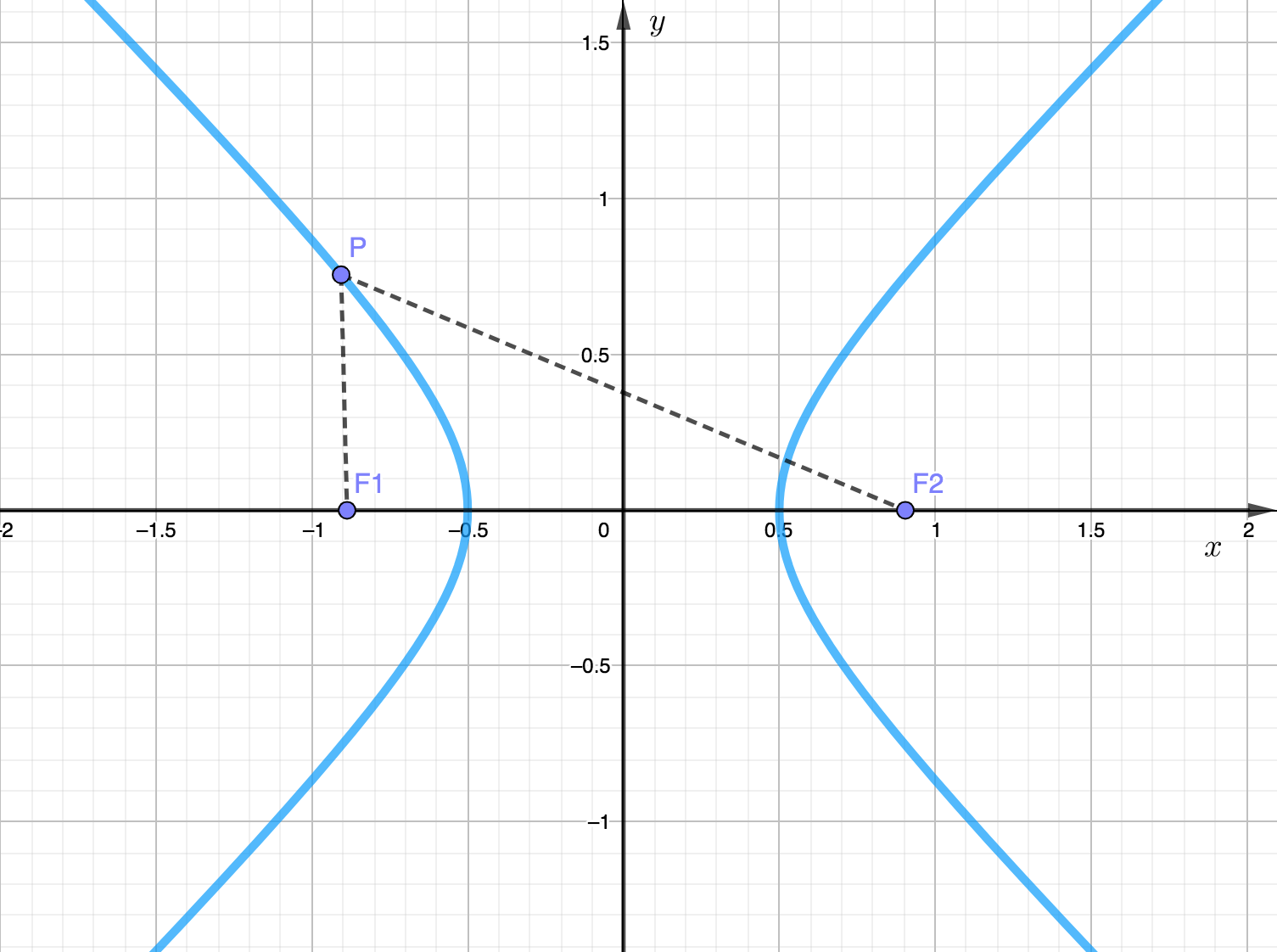
Notice that unlike other types of conic sections, hyperbolas are made up of two branches rather than one.
Geometrical Components of a Hyperbola
From a geometric point of view, a hyperbola is produced when a plane cuts parallel to the cone axis of a double-napped cone.
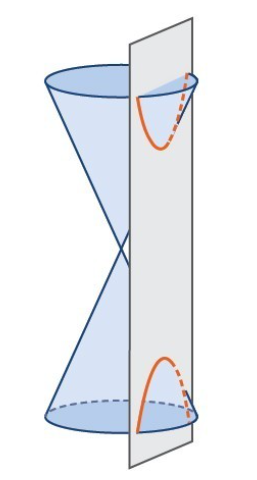
Let's explore more closely a graphical representation of a hyperbola. Here, we introduce more vital components that make up a hyperbola.
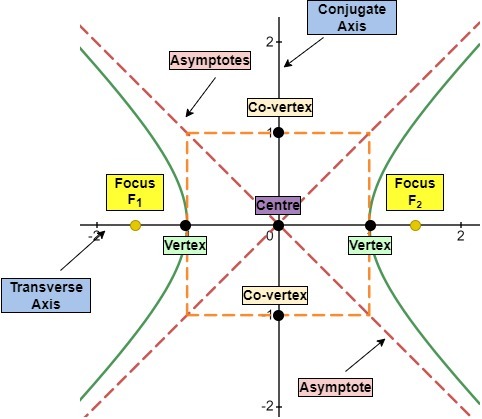
Every hyperbola has two axes of symmetry: the transverse axis and the conjugate axis
The conjugate axis (the y-axis) is a line perpendicular to the transverse axis and contain the co-vertices.
The transverse axis (the x-axis) is a line that passes through the centre of the hyperbola. The foci (focus F1 and focus F2) lie on the transverse line. The vertices are the points of intersection of both branches of the hyperbola with the transverse line. Both foci and vertices are symmetrical in relation to the conjugate axis, which implies that they'll have the same x-coordinate but with opposite signs.
The centre is the midpoint of the transverse axis and conjugate axis. This is where the two lines intersect.
Every hyperbola has two asymptotes (red dashed lines) that pass through the centre. As a hyperbola moves away from its centre, the branches approach these asymptotes. By definition, the branches of the hyperbola will never intersect it's asymptotes.
The central rectangle (orange dashed lines) is centred at the origin. The sides pass through each vertex and co-vertex.
It is helpful to identify this when graphing the hyperbola and its asymptotes. To draw the asymptotes of the hyperbola, all we have to do is extend the diagonals of the central rectangle.
Equations of Hyperbolas
Let us now derive the equation of a hyperbola centred at the origin.
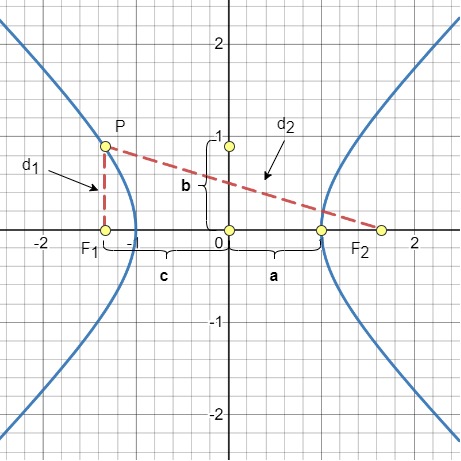
Let P = (x, y), and the foci of a hyperbola centred at the origin be F1 = (–c, 0) and F2 = (c, 0)
From the plot above, (a, 0) is a vertex of the hyperbola, and so the distance from (−c, 0) to (a, 0) is a − (−c) = a + c. Similarly, the distance from (c, 0) to (a, 0) is c − a.
The sum of the distances from the foci to the vertex is (a + c) − (c − a) = 2a. Let P(x, y) be a point on the hyperbola we want to investigate. From here, we can define d1 and d2 by:
d1 = distance from (c, 0) to (x, y)
d2 = distance from (–c, 0) to (x, y)
By definition, a hyperbola is the set of all points where the difference of the distance between (x, y) to the foci is constant. Thus, d2 - d1 is constant for any point (x, y) on the hyperbola. We know that the difference of these distances is 2a for the vertex (a, 0). So, d2 – d1 = 2a.
To find the equation of a hyperbola, we shall make use of the Distance Formula and solve our expression algebraically.
The Distance Formula
Recall that the Distance Formula for two points (x1, y1) and (x2, y2) is given by
By the Distance Formula between (-c, 0) and (c, 0)
Squaring both sides, we obtain
Expanding the binomials and cancelling like terms,
Now dividing both sides by 4 and squaring both sides,
Expanding this and cancelling like terms again yields,
This simplifies to
The distance between the foci is 2c with c2 = a2 + b2. Thus, we can set b2 = c2 - a2. In doing so, we obtain
Now dividing both sides by a2b2, the equation for the hyperbola becomes
as required! Below is a worked example that demonstrates the use of the Distance Formula in regards to hyperbolas.
Determine the equation of the hyperbola represented by the graph below.
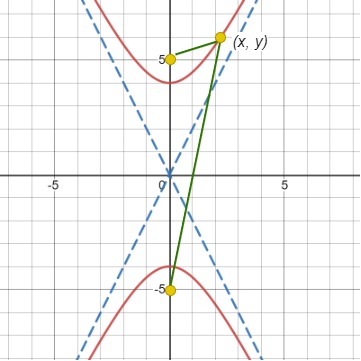
Solution
The hyperbola below has foci at (0 , –5) and (0, 5) while the vertices are located at (0, –4) and (0, 4). The distance between these two coordinates is 8 units.
Thus, the difference between the distance from any point (x, y) on the hyperbola to the foci is 8 or –8 units, depending on the order in which you subtract.
Using the Distance Formula, we obtain the equation of the hyperbola as follows.
Let,
d1 = distance from (0, 5) to (x, y)
d2 = distance from (0, –5) to (x, y)
By dividing the expression by our final yield becomes
Properties of Hyperbolas
Let us now move on to the properties of hyperbolas. There are two cases to consider here:
Locating the Foci and Vertices of a Given Hyperbola
Identify the foci and vertices for the hyperbola .
Solution
The equation is of the form
Thus, the transverse axis lies on the y-axis. The centre is at the origin, so the y-intercepts are the vertices of the graph. We can thus find the vertices by setting x = 0 and solve for y as below.
The foci are located at and by the relationship between a, b and c established before, we obtain
Thus, the vertices are (0, –7) and (0, 7) while the foci are (0, –9) and (0, 9). The graph is shown below.
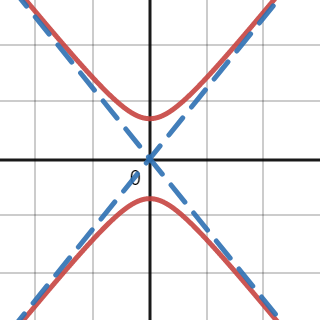
Identify the foci and vertices for the hyperbola .
Solution
The equation is of the form
Thus, the transverse axis lies on the y-axis. Here, h = 3 and k = 2, so the centre is at (3, 2). To find the vertices, we shall make use of the formula below.
The foci are located at and using as before, we obtain
Thus, the vertices are (3, –1) and (3, 5) while the foci are (0, –5.83) and (0, 5.83). The graph is shown below.
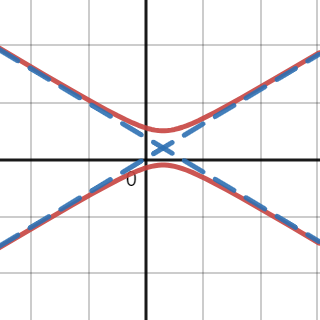
The equation for the asymptotes can be found using the formula given in the table. Give it a try for these examples! It is always helpful to sketch the asymptotes first before drawing the two branches of a hyperbola.
Finding the Equation of a Hyperbola Given the Foci and Vertices
Express the following hyperbola in standard form given the following foci and vertices.
Solution
Notice that the vertices and foci are on the x-axis. Hence, the equation of the hyperbola will take the form
Since the vertices are then
Given the foci are then
Solving for b2 we obtain
Now that we have found a2 and b2, we can substitute this into the standard form as
The graph is shown below.
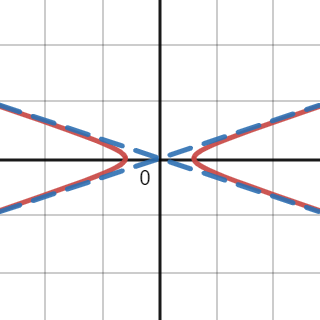
Express the following hyperbola in standard form given the following foci and vertices.
Solution
The vertices and foci have the same x-coordinates, so the transverse axis is parallel to the y-axis. The equation of the hyperbola will thus take the form
We must first identify the centre using the midpoint formula. The centre lies between the vertices (1, –2) and (1, 8), so
The length of the transverse axis, 2a, is bounded by the vertices. To find a2 we must evaluate the distance between the y-coordinates of the vertices.
The coordinates of the foci are
Using k + 3 = 16 and substituting k = 3, we obtain
Thus, we can solve for b2 by
Finally, substituting these values into the standard form, we obtain
The graph is shown below.
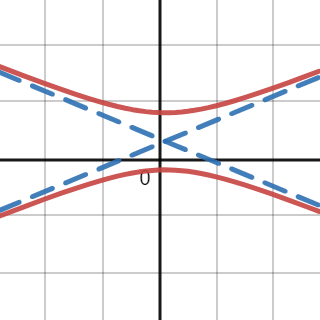
Graphing Hyperbolas
In this final section, we shall graph hyperbolas using the concepts introduced throughout this lesson.
Graph an Equation in Standard Form
Let us return to our previous examples for this segment,
Graph the hyperbola
Solution
As you can see, the hyperbola is already in the standard form.
This means that we have a pair of curves opening from the left and right. The vertices are and the foci are . The centre of the hyperbola is the origin, (0, 0). Here,
The equation of the asymptotes are
Always sketch the asymptotes when graphing hyperbolas. That way, we can accurately draw the curves associated with the equation.
The graph of is shown below.
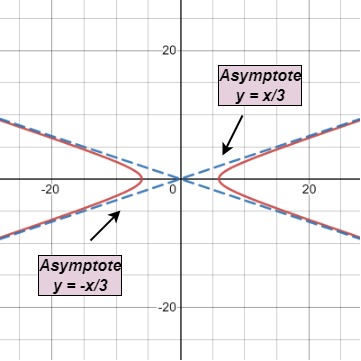
Graph an Equation Not in Standard Form
In this section, it may be helpful to recall the method of Completing Squares to solve such problems.
Graph the hyperbola below.
Solution
To solve this expression, we must attempt to rearrange this in the standard form of a hyperbola. We do this by completing the square as follows.
We need to identify A and B. In doing so, we obtain
Dividing both sides by 225, we obtain the equation
The centre is (2, –1). We also have the values . Thus we obtain the following values for the vertices, foci and asymptotes.
The vertices
The foci
The asymptotes
The graph of is shown below.
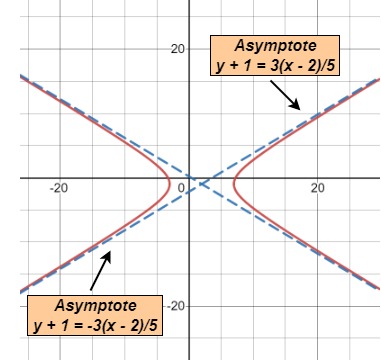
The Eccentricity of a Hyperbola
The eccentricity of a conic section describes how closely related the curve is compared to a circle. The eccentricity is described by the variable e.
The eccentricity of a circle is zero, e = 0.
The eccentricity of a hyperbola is always more than 1, e > 1. The formula for finding the eccentricity of a hyperbola is given below.
Formula: Eccentricity of a Hyperbola
The bigger the eccentricity, the less curved the conic section is.
Find the eccentricity of the hyperbola
Solution
Here, a2 = 25 and b2 = 9. Thus, the eccentricity of this hyperbola is given by
Hyperbolas - Key takeaways
- To locate the vertices and foci given the equation of a hyperbola in standard form, we adopt the following steps:
- Identify the location of the transverse axis
|
|
- Solve for a using
- Solve for c using
- To express an equation in standard form given the vertices and foci for a hyperbola centred at (0,0), we use the method below:
- Determine the location of the transverse axis
|
|
- Solve for b2 using b2 = c2 - a2
- Substitute a2 and b2 into the standard form established in Step 1
- To write an equation in standard form given the vertices and foci for a hyperbola centred at (h,k), we apply the technique below:
- Decide whether the transverse axis is parallel to the x-axis or y-axis
|
|
- Identify the centre of the hyperbola, (h, k) using the Midpoint Formula given coordinates of the vertices
- Evaluate a2 by solving the length of the transverse axis, 2a. This is given by the distance between the two vertices
- Evaluate c2 by using the coordinates of the given foci and the values of h and k determined in Step 2
- Solve for b2
- Substitute a2, b2, h and k into the standard form established in Step 1






















